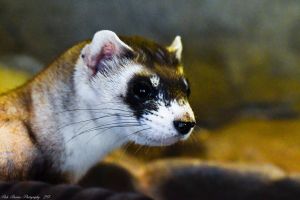- Black-footed ferrets as a keystone species and their ecological role
- Historical decline and near extinction of the black-footed ferret
- Recovery efforts and conservation strategies
- Impact of black-footed ferrets on prairie ecosystems
- Zoo management and their role in black-footed ferret conservation
The black-footed ferret, Mustela nigripes, is not just another mammal inhabiting the plains of North America; it plays a pivotal role in preserving the ecological balance of prairie ecosystems. This species is categorized as a keystone species, functioning as indispensable predators within their native environment. Their primary dietary preference for prairie dogs enables them to regulate populations and maintain vegetation, ensuring ecosystem stability with wide-reaching benefits to the diverse species that share this habitat.
Black-footed ferrets once thrived across the grasslands in the central and western United States and Canada. However, by the late 1970s and early 1980s, they were declared extinct due to habitat destruction, disease, and the decline of prairie dog populations upon which they heavily relied. In 1981, a remarkable discovery of a small ferret population in Meeteetse, Wyoming, rekindled hope for the species. This unexpected find marked the beginning of conservation efforts to reinvigorate and reestablish black-footed ferrets in their historical range.
The narrative surrounding the black-footed ferret’s recovery is one of determination and collaboration. Conservation strategies encompassing captive breeding, habitat restoration, and reintroduction have become the cornerstone of efforts to bolster their numbers. Breeding programs headquartered in various locations, such as the National Black-footed Ferret Conservation Center in Colorado, focus on increasing the genetic diversity and population size of the ferret. These initiatives aim to produce individuals capable of survival and reproduction in the wild. Through these rigorous programs, captive-born ferrets are reintroduced into areas where prairie dog colonies still thrive, offering a renewed lease on life within their original home ranges.
The reintroduction of black-footed ferrets has a multi-dimensional impact on prairie ecosystems. As efficient hunters, they control prairie dog populations, preventing these herbivores from overexploiting vegetation. This natural check on grazing activities by prairie dogs serves a dual purpose; it maintains the health and diversity of the prairie plant community and supports various other animals, including birds, reptiles, and insects that depend on intact grasslands for survival. The intricate web of interactions emphasizes the substantial ripple effect one species can have on the broader ecosystem.
Integrating zoo management techniques into black-footed ferret conservation highlights the importance of ex-situ conservation practices in wildlife recovery efforts. Zoos and wildlife reserves offer controlled environments that aid in the study and breeding of ferrets. Through educational programs and public engagement, these institutions raise awareness of the black-footed ferret’s plight, encouraging support for broader conservation initiatives. Also, zoos are essential for facilitating research into ferret biology, veterinary care, husbandry, and behavior, providing valuable insights that inform in-situ conservation strategies.
In-depth understanding and continuous support are vital for the sustained recovery of black-footed ferrets. Inter-agency collaboration, private landowner partnerships, and community involvement are crucial components of these efforts. By fostering a connection between people and prairie ecosystems, conservationists aim to develop a cultural and societal commitment towards protecting this keystone species. The successful resurgence of black-footed ferrets represents a significant conservation victory and offers a blueprint for similar efforts targeting other endangered species.
As efforts progress, it remains vital to address challenges such as habitat fragmentation, disease outbreaks like sylvatic plague, and the political and economic factors that affect land use policies. By maintaining and enhancing the habitats of the black-footed ferret, conservationists strive to ensure the long-term viability of this charismatic species and the ecosystems they support.
The journey of the black-footed ferret demonstrates the power of coordinated conservation efforts, scientific research, and community involvement in preventing extinction. Today, the black-footed ferret stands as a symbol of hope and resilience, embodying the potential for human intervention to reverse the decline of wildlife populations. With ongoing dedication, the once-endangered black-footed ferret can continue to thrive and fulfill its role as a keystone species, ensuring the health and balance of North America’s prairies for generations to come.
*****
Source Description
Did you know that black-footed ferrets are known as a keystone species? They get this title due to being top predators in their ecosystem! Their presence has a significant effect on maintaining a healthy balance in prairie ecosystems. They control prairie dog populations and help prevent overgrazing of plants, benefiting the entire community.
Black-footed ferrets were once considered extinct in the wild. By the 1980s, they were believed to be gone forever, but a small population was discovered in Wyoming in 1981. Today, they are one of the rarest mammals in North America, though recovery efforts are ongoing to bring their numbers back.


